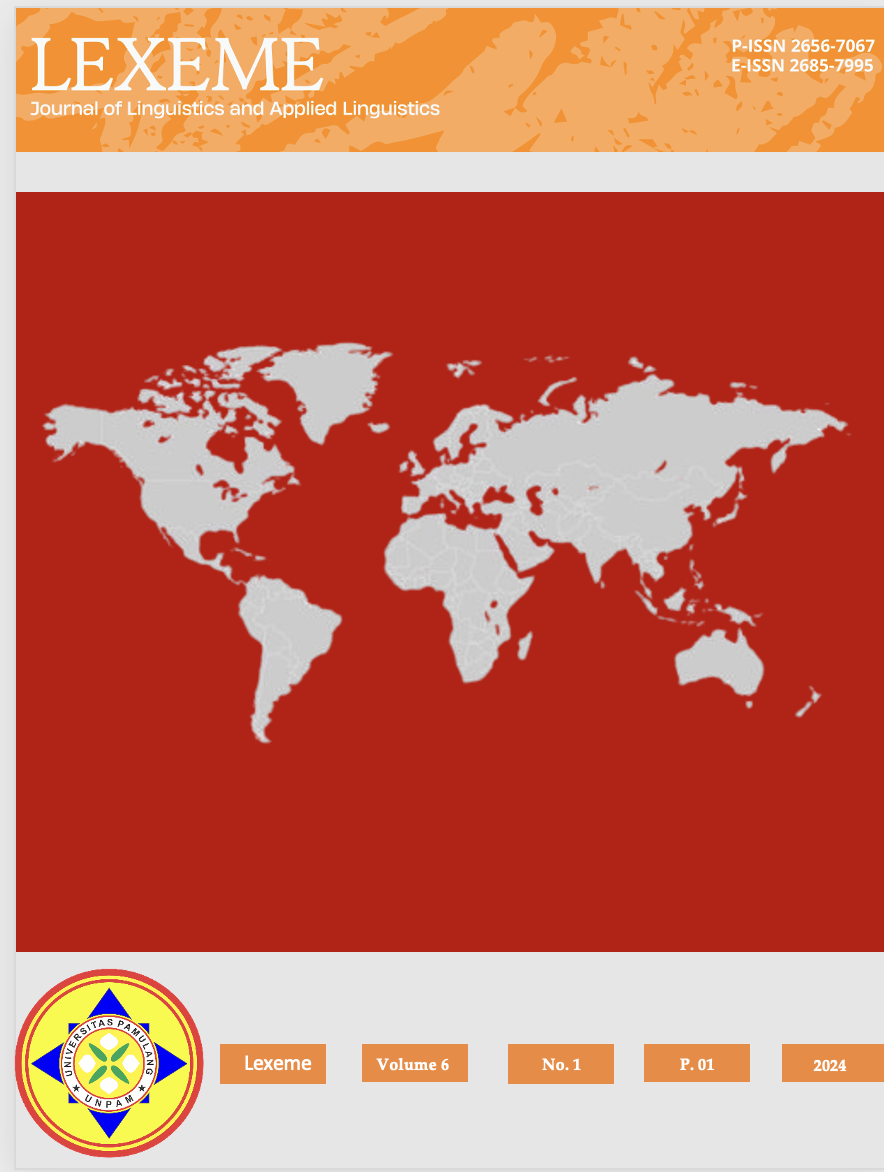A Case Study on Grammatical Errors in Students' Descriptive Writing at Al Ghozali Senior High School
DOI:
https://doi.org/10.32493/ljlal.v6i1.41885Keywords:
Error Analysis, Grammatical Errors, Descriptive WritingAbstract
The motivation behind this research stems from the observed challenges faced by high school students in mastering English grammar, particularly in writing. This study investigates the grammatical errors frequently made by tenth-grade students in their descriptive writing at Al Ghozali Senior High School, Gunung Sindur, Bogor. The primary objective is to analyze these errors to understand their nature and frequency, providing insights for more effective teaching strategies. This descriptive research utilizes a documentary analysis method, focusing on students' written works. The research subjects are tenth-grade students at Al Ghozali Senior High School. Data collection involved gathering students' descriptive essays, which were then analyzed using a checklist of common grammatical errors adapted from La Trobe University. The checklist includes categories such as subject-verb agreement, verb tense, word class, vocabulary, singular/plural, articles, sentence structure, spelling, and punctuation. Data analysis revealed that the most frequent errors involved subject-verb agreement (94.47%), followed by verb tense (66.66%) and word class (57.14%). Other common errors included vocabulary usage, singular/plural distinctions, and article usage. These findings highlight specific areas where students struggle the most, providing valuable information for educators. The implications of this research suggest that targeted interventions and continuous practice are essential for improving students' grammatical skills in writing. By addressing the identified errors, teachers can enhance their instructional methods, ultimately helping students achieve better proficiency in English writing. This study not only benefits students and teachers at Al Ghozali Senior High School but also offers insights for future research in similar educational contexts.
References
Andewi, W., & Hastomo, T. (2022). Effect of Using Flipped Classroom for Teaching Writing Based on Students’ Motivation: A Quasi-Experimental Research. Premise: Journal of English Education and Applied Linguistics, 11(3), 615–631. https://doi.org/10.24127/PJ.V11I3.5511
Brown, H. D. (2004). Language Testing Book: Principles and Classroom Practice. Book, 314.
Cahyono, B. Y., & Rahayu, T. (2020). EFL students’ motivation in writing, writing proficiency, and gender. TEFLIN Journal - A Publication on the Teaching and Learning of English, 31(2), 162–180. https://doi.org/10.15639/teflinjournal.v31i2/162-180
Creswell, J. W. (2012). Educational research: Planning, conducting and evaluating quantitative and qualitative research. Pearson Education.
Deiniatur, M., & Cahyono, B. Y. (2024). Digital literacy practices of novice English as a foreign language teacher in writing research articles for publication. Journal of Education and Learning (EduLearn), 18(1), 165–172. https://doi.org/10.11591/edulearn.v18i1.20899
Hastomo, T. (2016). The Effectiveness of Edmodo To Teach Writing Viewed From Students ’ Motivation. Proceeding of International Conference on Teacher Training and Education 1 (1), 1, 580–585.
Hastomo, T. (2019). Schoology Effects on Students’ Writing Ability. Lentera: Jurnal Ilmiah Kependidikan, 12(1), 149–154.
Hastomo, T., & Septiyana, L. (2022). The investigation of students’ engagement in online class during pandemic COVID-19. Jurnal Penelitian Ilmu Pendidikan, 15(2). https://doi.org/10.21831/JPIPFIP.V15I2.49512
Hastomo, T., & Zulianti, H. (2021). EFL Students’ Perceptions on the Use of Google Meet in Online Learning During the Time of Coronavirus: A Literature Review. SELTICS, 4(2), 102–109. https://doi.org/10.46918/SELTICS.V4I2.916
Istiara, F., & Hastomo, T. (2023). Exploring lecturers and administrative staffs’ strategies to hone EFL students’ digital literacy. JOALL (Journal of Applied Linguistics and Literature), 8(1), 151–172. https://doi.org/10.33369/JOALL.V8I1.25568
Kharmilah, P., & Narius, D. (2019). Error Analysis in Writing Discussion Text Made by Students at English Department of Universitas Negeri Padang. Journal of English Language Teaching, 8(3), 327–335. https://doi.org/10.24036/JELT.V8I3.105228
Metaria, M., & Cahyono, B. Y. (2024). EFL students’ engagement in the post-pandemic teaching: Does technology matter? Journal on English as a Foreign Language (JEFL) , 14(1), 26–47. https://doi.org/10.23971/jefl.v14i1.6503
Miranty, D., Widiati, U., Cahyono, B. Y., & Sharif, T. I. S. T. (2023). Automated writing evaluation tools for Indonesian undergraduate English as a foreign language students’ writing. International Journal of Evaluation and Research in Education (IJERE), 12(3), 1705–1715. https://doi.org/10.11591/IJERE.V12I3.24958
Patton, M. Q. (2002). Qualitative research and evaluation methods (3rd ed.). Sage Publications.
Rochmadi, I. (2020). Error Analysis of English Written Text of Higher Level English Foreign Language Learners. International Journal of English Learning and Applied Linguistics (IJELAL), 1(1), 44–55. https://doi.org/10.21111/IJELAL.V1I1.5009
Yulistiani, E., Supriyono, S., Wicaksono, A., & Hastomo, T. (2020). The Correlation between Vocabulary Mastery, Reading Habits, and The Students’ Writing Ability. IJLHE: International Journal of Language, Humanities, and Education, 3(1), 69–76.
Downloads
Published
How to Cite
Issue
Section
License
Copyright (c) 2024 Sunardi Y, Mursyid Anwar

This work is licensed under a Creative Commons Attribution-ShareAlike 4.0 International License.







